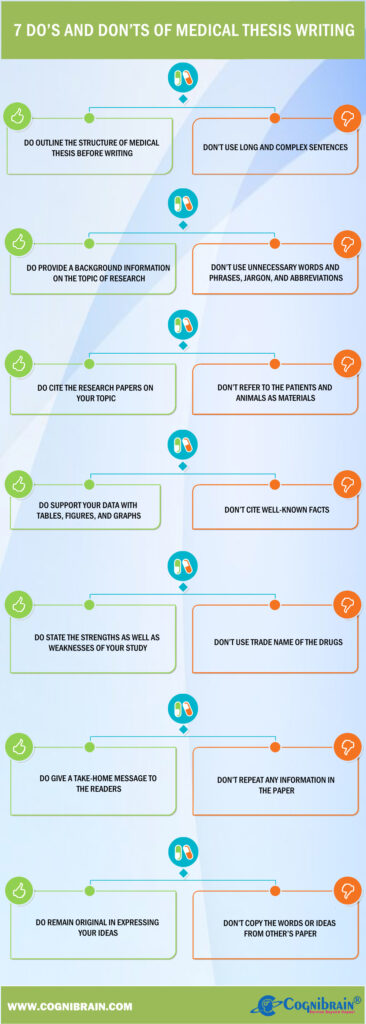Writing a medical thesis is always cumbersome and time-consuming for the research scholars. However, you can save your valuable man–hours and write a flawless thesis by paying attention to the Do’s and Don’ts for medical thesis writing.

Writing a medical thesis is always cumbersome and time-consuming for the research scholars. However, you can save your valuable man–hours and write a flawless thesis by paying attention to the Do’s and Don’ts for medical thesis writing.

A medical thesis is the written work resulting from an original research in the field of Medicine, Nursing, Pharmacy, and other health and life sciences. It is submitted by the students in order to obtain a higher degree from the University.
However, keep this in mind! The purpose of submitting a medical thesis is not limited to the achievement of a doctoral or post-graduate degree. It is a medium to organize the scientific knowledge in a way to make further progress in the field.
That’s the reason why the experts in medical thesis writing stress on the importance of choosing the right topic for your thesis. You must be able to address a genuine problem or series of problems through your medical thesis. Choose a topic that aligns with your interest and where you can offer a fresh perspective through your research study.
After choosing the topic for your research study, collaborate with your supervisor to design your research study and its goal. Collect all the information and data pertaining to your research before proceeding with your clinical trials.
Now, you are ready with your research data and clinical findings. You just need to pen down your findings in your medical thesis.
That sounds easy, isn’t it?
In reality, it’s not so. But, you need not worry! Writing a medical thesis becomes easy and fun if you follow the given steps with competence:
Prepare an outline of the thesis in accordance with the following sections:
List the major sections and chapters in each. Do a section at a time. Assemble all the figures and tables and organise them into a logical sequence.
The title reflects the content of your thesis. For writing a perfect thesis title:
The purpose of writing an Introduction is to provide the reader with sufficient background information on the topic and help him understand and evaluate the results of the present study, without needing to refer to the previous publications on the topic.
Do’s
Cite the research papers written on your research topic
Don’ts
This section must be so written that the reader is able to repeat the study and validate its findings.
Write a detailed exposition about the participants in the study, what materials you used and how you analyzed the results
Don’ts
Keep in mind the objective of your research while writing the “Results” section. The findings of the research can be documented in the form of:
Use text to summarize small amounts of data. Do not over-use tables, figures, and graphs in your paper. Moreover, do not repeat information presented in the table or figure in the text format. Text must be a summary or highlight of the information presented in tables or figures.
Good medical theses have a targeted discussion keeping it focused on the topic of the research. Include:
The conclusion of your research study must comprise of:
However, avoid any statement that does not support your data.
With these tips, write your thesis like a pro and don’t let it delay your doctoral award!
Plagiarism, simply known as literary theft, is defined as the practice of using other’s work or ideas in your scientific writing without giving them due credit and passing them off as one’s own in publication journals to gain recognition.
Publishing their research in high-impact journals is a matter of reputation for every scientist or research scholar. However, plagiarism can blemish this reputation and you stand a high chance of rejection by the journal.
If you don’t want this to happen to you, avoid plagiarism and improve your scientific writing
with these easy-to-follow steps:
Remember, there is no shortcut to success; neither to scientific research, nor scientific writing!
If your deadline for project submission is near? You don’t have the time to edit and proofreads your scientific paper?Cognibrain is there for you, offering its advanced scientific writing services and editing services with quick turn-around time.